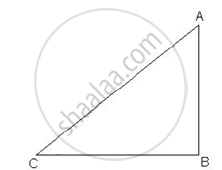Advertisements
Advertisements
Question
Without using trigonometric tables, evaluate :
`("cosec" 42^circ)/sec 48^circ`
Solution
`("cosec" 42^circ)/sec 48^circ`
= `("cosec" (90^circ - 48^circ))/sec 48^circ`
= `sec 48^circ/sec 48^circ` [`because` sec (90-θ) = cosec θ]
= 1
APPEARS IN
RELATED QUESTIONS
In the below given figure, a tower AB is 20 m high and BC, its shadow on the ground, is 20√3 m long. Find the sun’s altitude.

Without using trigonometrical tables, evaluate:
`cosec^2 57^circ - tan^2 33^circ + cos 44^circ cosec 46^circ - sqrt(2) cos 45^circ - tan^2 60^circ`
Without using trigonometric tables, evaluate
`sin^2 34^@ + sin^2 56^@ + 2tan 18^@ tan 72^@ - cot^2 30^@`
Prove the following identities, where the angles involved are acute angles for which the expressions are defined:
(cosec A - sin A) (sec A - cos A) = `1/(tanA+cotA)`
[Hint: Simplify LHS and RHS separately.]
Without using trigonometric tables, prove that:
tan 71° − cot 19° = 0
Without using trigonometric tables, prove that:
cosec272° − tan218° = 1
Without using trigonometric tables, prove that:
tan266° − cot224° = 0
Without using trigonometric tables, prove that:
cos257° − sin233° = 0
Prove that:
`sin 18^circ/(cos 72^circ )+ sqrt(3)(tan 10^circ tan 30^circ tan 40^circ tan50^circ tan 80^circ) `
Prove that:
\[\frac{\sin\theta \cos(90^\circ - \theta)\cos\theta}{\sin(90^\circ- \theta)} + \frac{\cos\theta \sin(90^\circ - \theta)\sin\theta}{\cos(90^\circ - \theta)}\]
Prove that:
\[cot\theta \tan\left( 90° - \theta \right) - \sec\left( 90° - \theta \right)cosec\theta + \sqrt{3}\tan12° \tan60° \tan78° = 2\]
If A, B and C are the angles of a ΔABC, prove that tan `((C + "A")/2) = cot B/2`
If tan 2 A = cot (A − 12°), where 2 A is an acute angle, find the value of A.
If 5 tan θ = 4, find the value of `(5 sin θ + 3 cos θ)/(5 sin θ + 2 cos θ)`
Solve the following equation: `(cos^2θ - 3 cosθ + 2)/sin^2θ` = 1.
The maximum value of `1/(cosec alpha)` is ______.
